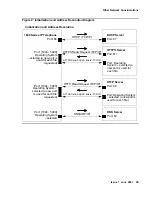
Other Network Considerations
Issue 1 June 2007
27
This capability also has the advantage of making station number portability easier. Assume a
situation where the company has multiple locations in London and New York, all sharing a
corporate IP network. Users want to take their telephones from their offices in London and bring
them to New York. When users start up their telephones in the new location, the local DHCP
server usually routes them to the local call server. With proper administration of the local DHCP
server, the telephone knows to try a second call server IP address, this one in London. The user
can then be automatically registered with the London call server.
Chapter 5: Server Administration
contains details on administration of DHCP servers for lists of
alternate media servers, router/gateways, and HTTP/HTTPS servers. For more information,
see
DNS Addressing
on page 70.
TCP/UDP Port Utilization
The 1600 Series IP Telephones use a variety of protocols, particularly TCP and UDP, to
communicate with other equipment in the network. Part of this communication identifies which
TCP or UDP ports each piece of equipment uses to support each protocol and each task within
the protocol. For additional TCP/UDP port utilization information as it applies to Avaya
Communication Manager, see
UDP Port Selection
on page 32.
Depending on your network, you might need to know what ports or ranges are used in the
operation of 1600 Series IP Telephones. Knowing these ports or ranges helps you administer
your networking infrastructure.
In
Figure 1
and
Figure 2
:
●
The box on the left always represents the 1600 Series IP Telephone.
●
Depending on the diagram, the boxes on the right refer to various pieces of network
equipment with which the telephone can communicate.
●
Open-headed arrows (for example,
) represent the direction(s) of socket
initialization.
●
Closed-headed arrows (for example,
) represent the
direction(s) of data transfer.
●
The text the arrows point to identifies the port or ports that the 1600 Series IP Telephones
support for the specific situation. Brackets identify ranges when more than one port
applies. The text indicates any additional qualifications or clarifications. In many cases, the
ports used are the ones called for by IETF or other standards bodies.
















































